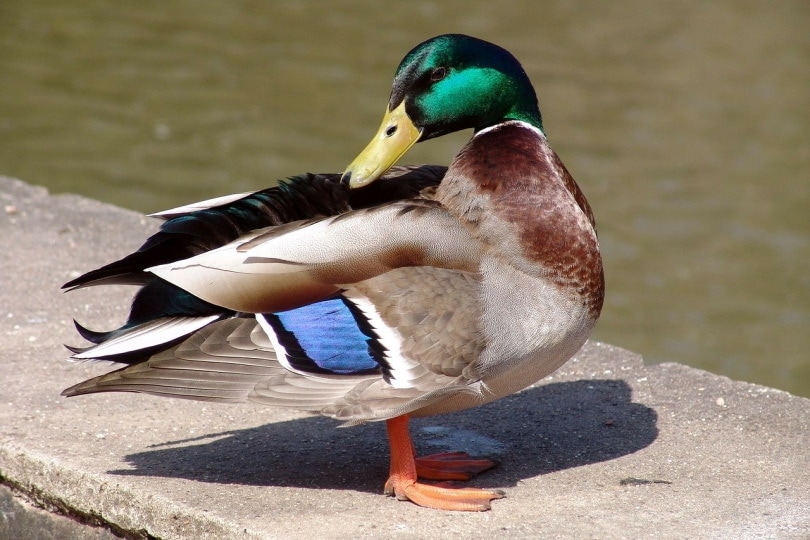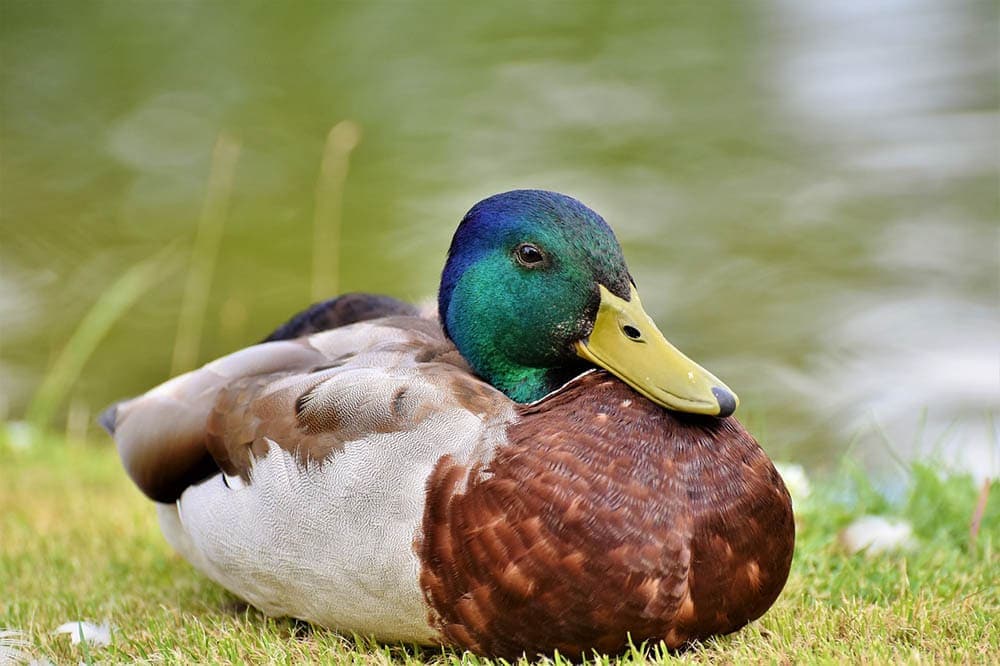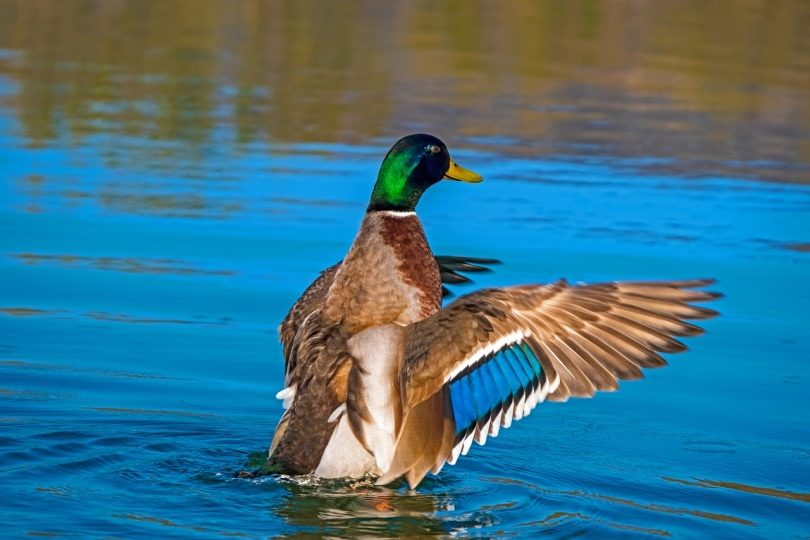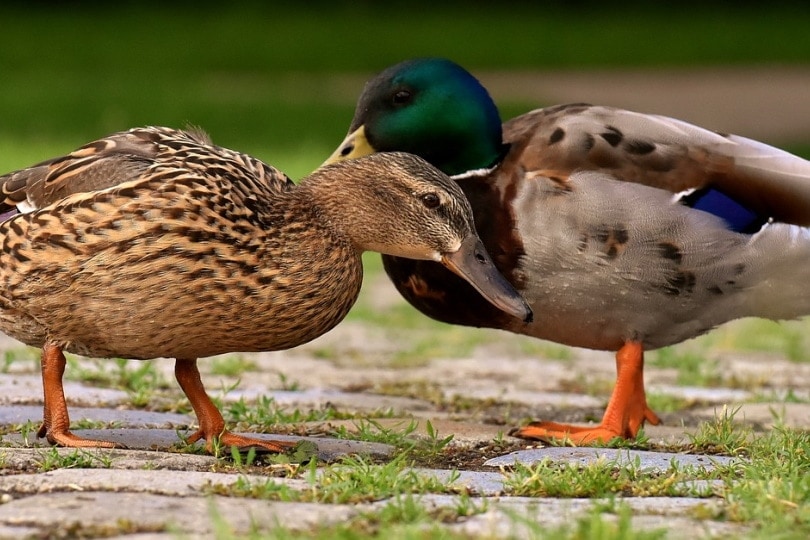Mallard Duck: Field Guide, Pictures, Habitat, and Info
Last Updated on

Do you love mallard ducks? Do they pique your interest in birdwatching? Well, in this article, our goal is to show you all about the mallard duck, including info on their lifestyle, conservation, and unique characteristics that make them an enjoyable sight to see. Stay tuned for some tips on how you can bring them into your backyard.

Quick Facts About Mallard Ducks

| Habitat: | Ponds, lakes, and wetlands |
| Diet: | Omnivorous |
| Behavior: | Dabbling |
| Nesting: | Ground |
| Conservation: | Low-risk |
| Scientific name: | Anas platyrhynchos |
| Lifespan: | 5–10 years |
Mallard Duck General Description
The mallard duck is one of the leading dabbling birds in North America in terms of its population and familiarity, if not the most common. A male mallard has a vibrant, emerald green head that has a distinct separation from the rest of his plumage. They also have a yellow bill, unlike the females’ orange bill.
The females have an all-brown body, which is only a portion of the male’s total color. Both male and female mallards have a set of blueish tints on their wings, which can be best seen when they are in flight.
Mallard Duck Range, Habitat, Behavior, and Nesting

Range
Mallards are predominantly found throughout the majority of North America, spanning from the Alaskan tundra all the way down to the borders of Mexico They breed in the north in Canada and Alaska but migrate south when the temperatures drop. Throughout a great majority of the contiguous states, they live year-round.
Habitat
This species mostly lives in areas with still water, such as ponds, lakes, or calm rivers that lie in subtropical or temperate environments. They can be found close to the ocean, as the saltwater increases their buoyancy. Here, they will only stay if the water is still, so they tend to stay inland near marshes or wetlands.
Behavior
As dabbling birds, their primary instinct is to stay afloat and pick at aquatic vegetation or bugs scattered across the water’s surface. They don’t “dive” like loons or the like, which some people may believe.
Nesting
Mallard ducks generally nest on the ground in areas with vegetation that can keep them out of sight from predators. Things like ferns, grass, or even tree stumps may be their home.

How to Find Mallard Ducks: Birdwatching Tips

What to Listen For
If you’ve ever been to a pond or lake, you may have heard the “quacking” sound that pretty much symbolizes what many people know as the most distinctive trait of a duck. Listen for these calls and expect to see a female, as it can indicate courting. Male mallards aren’t as loud and have more coarse vocals.
What to Look For
As you’re out on the hunt for a mallard, you’ll want to look for still water areas where there is no strong current, as this would make it difficult for them to float around. A duck that roams in parks with lots of human traffic will not be hard to spot, as they may be comfortable enough to get close. Yet, if you’re off the beaten path, it would be advisable to check areas that have a reasonable amount of grass and ferns, as it’s a good place for them to stay hidden. Also, check for any loose feathers since it could prove there is a nest here.
When to Look
You’ll have better luck during the day to see them floating in the water, but as night falls or morning breaks, they may be on land resting near low-lying vegetation.
Attracting Mallard Ducks to Your Backyard: Tips and Tricks

Tip 1. Make Them Feel at Home
To bring ducks to your back porch, you’ll be much better off if you live next to a freshwater pond, lake, still river, or wetland area that will be part of their natural habitat. It’s also possible to attract them if you’ve built an artificial pond, but it has to be a reasonable size for any luck.
In that case, you can also add some ferns, tall grass, rocks, logs, or similar objects to match where they tend to live. Otherwise, you’ll need to visit a local park that offers this environment.
Tip 2. Set Up Your Pool
Some ducks have been known to visit outdoor swimming pools while homeowners aren’t looking, as they are just another place for them to relax and feel at ease. You might even find an entire family here if the pool is large enough.
Tip 3. Use the Right Food
In general, it’s best to let ducks thrive without human interaction since it can shy them away from foraging for their own grub. However, if you want to feed them at your own discretion, then you should note which things to and not give them.
You might be tempted to grab a loaf of bread and feed it to the ducks like the majority of people do, but keep in mind that this isn’t a healthy option for them. Instead, the better choice is to feed them fresh vegetables or fruits like lettuce, corn, tomatoes, or broccoli. Rice and peas are fine, but there is a higher chance for them to choke on these.
Mallard Duck Conservation: Is This Bird Threatened?
The mallard duck’s primary threat is the change of migratory paths due to climate change. It’s possible that their patterns could open into even more regions of northern Canada that are currently too cold for them to stay but lose a portion of the area in Mexico and the Southern US. These ducks also are the target of many dog-hunter duos for sport or a meal. However, their numbers are strong, and it is unlikely in the near future that their population will decrease significantly.

Conclusion
Mallard ducks have a strong place in North American wildlife, as they are commonplace in almost every freshwater environment that they can set their feet in. Their prominence attributes to them being beloved aquatic birds, but it also means that we should keep our interactions with them to a minimum since they are fed so heavily by others.
In any respect, we hope this field guide pushes you in the right direction so you can see one of the world’s favorite ducks right in your backyard!
Featured Image Credit: AnnaER, Pixabay
About the Author Robert Sparks
Robert’s obsession with all things optical started early in life, when his optician father would bring home prototypes for Robert to play with. Nowadays, Robert is dedicated to helping others find the right optics for their needs. His hobbies include astronomy, astrophysics, and model building. Originally from Newark, NJ, he resides in Santa Fe, New Mexico, where the nighttime skies are filled with glittering stars.
Related Articles:
10 Types of Hummingbirds in Arkansas (With Pictures)
8 Types of Hummingbirds in Nebraska (With Pictures)
5 Types of Hummingbirds in Idaho (With Pictures)
3 Types of Hummingbirds in Mississippi (With Pictures)
8 Types of Hummingbirds in Kansas (With Pictures)
5 Types of Hummingbirds in West Virginia (With Pictures)
5 Types of Hummingbirds in Ohio (With Pictures)
Where Do Nuthatches Nest? Nuthatch Nesting Habits Explained
